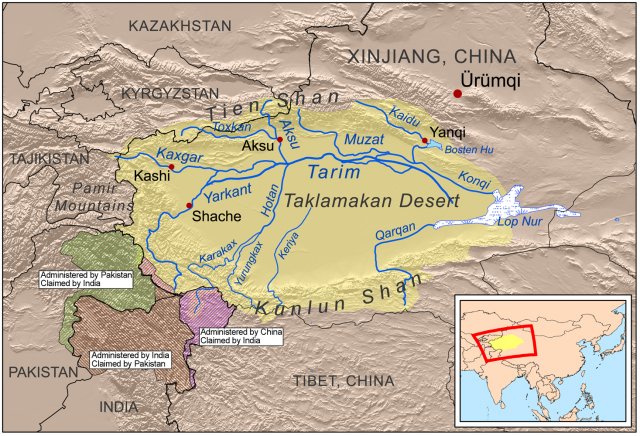Tarim Basin
THE TARIM BASIN designates a major river and great basin located in the Uighur Autonomous Region of Sinkiang of extreme northwestern CHINA, north of the TIBETAN PLATEAU. Tarim also connotes the bank of a river that flows into a lake or that becomes indistinguishable from desert sands. The basin occupies nearly one half of Sinkiang and is encircled by the TIAN SHAN (Celestial Mountains) to the north, the Pamir Mountains on the west, and the Kunlun Mountains in the south. It is 850 mi (13,687 km) east to west and nearly 350 mi (564 km) north to south. The Tarim Basin is also known T'a-li-mu Ho (Wade-Giles Romanization), Tarim He (Pinyin), and Dayan (Mandarin).
The basin comprises 215,000 square mi (557,000 square km), has a central desert with scattered, isolated oases along the rim, and lies at an elevation of 2,500 ft (760 m) above mean sea level in the east, rising to 4,000 ft (1,220 m) in the west. The central desert, Takla Makan (Taklimakan, Taklamakan), covers an area of 105,000 square mi (271,950 square km and includes at its eastern end the Turfan Depression 505 ft (154 m) below sea level.

The Tarim River flows along the north rim of the Takla Makan desert but constantly shifts its bed and is formed by the confluence of the K'a-shih-ka-erh (Kashgar) and Yarkand rivers to the west, then flows northeast to be joined 230 mi (370 km) downstream by the A-k'o-su and the Ho-t'ien (Khotan) rivers. The Yarkand-Tarim system is 1,260 mi (2,030 km) long and reaches Lop Nor, a saline lake bed, at the eastern end of the basin and drains intermittently into Lake T'ai-t'e-ma (Taitema) 100 mi (161 km) southwest of Lop Nor. The Lower Tarim Basin, an arid plain composed of alluvium and lake sediments, is the driest region of Eurasia.
Archaeological evidence documents that the basin was a part of the Silk Road and that people thrived there from 1800 B.C.E. to 500 C.E. Especially intriguing are the mummified remains of many Caucasoids and Mongoloids. The Tarim became a barrier to Chinese expansion west and Arab expansion eastward. The contemporary local population numbers 5.5 million and is composed of Uighur Muslims (84 percent), Han Chinese (12.5 percent), Kirgiz, Mongols, and Kazaks. The largest city is Kashgar (Kashi) located in the west and the capital is at Wu-lu-mu-ch'i.